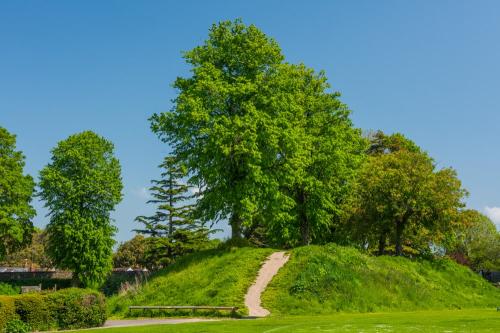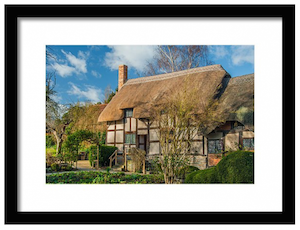
In 1067, the year following his successful invasion of England, William the Conqueror granted the estates of Chichester and Arundel to a distant relative, Roger de Montgomery, along with another 155 lordships throughout the newly conquered English realm.
Montgomery, named by William the 1st Earl of Shrewsbury and Earl of Arundel, built a motte and bailey fortification at Chichester. This new castle was one of 11 Norman fortifications built in Sussex in the years immediately following the Norman invasion.
The new castle was located in the northeastern corner of the city, within the city walls. As with most early Norman castles, the new fortification followed a simple plan, with a motte, or earthwork mound, surmounted by a timber palisade.
The motte was surrounded by a wide ditch and bank called a bailey, and within this bailey were secondary buildings such as a stable, bakehouse, and kitchen.

Who Lived Here?
Earl Roger did occasionally reside at Chichester Castle, but his main residence was at Arundel, and Chichester Castle would have been maintained by a castle warden, or administrator, on the Earl's behalf.
The castle was only partly built for defence, but a primary purpose was simply to impose the Norman presence on an existing Saxon town.
History
Records show that Chichester Castle had its own chapel by 1142. It also had a permanent garrison of up to 20 soldiers. Sometime during the reign of Henry II (1133-1189), the castle was granted to the Earls of Sussex, but it later passed into Crown control. By the early part of the 14th century it was being used as a prison and court of justice.
Chichester Castle was captured by the French in 1216 as part of the First Barons' War; the nobles' struggle for power against King John. It was retaken by English troops in 1217. To prevent it being used against him, King Henry III ordered the castle to be destroyed.
Richard, Earl of Cornwall, then gave the castle site to the monastic order of Greyfriars (the Franciscan Order of Friars Minor) and a friary was built amid the castle ruins. The only obvious reminder of the friary is the Guildhall, built in 1282 as the chancel of the friary church.
What to See
Only the castle motte remains today. The motte stands a stone's throw from the 13th-century Guildhall, in the northeast corner of Friary Park, off Priory Road and the A286. The low, turf-covered mound has been planted with trees and it is easy to climb to the top for views across the park.
The mound we see today gives only a hint as to the size and scale of the original Norman castle. The 11th-century motte would have been four to five times the size.
In recent years, archaeological digs have taken place to explore the remains hidden beneath the grass. This dig exposed a section of limestone wall which may have been part of a bridge spanning a ditch that defended the motte. The wall utilised stone from Selsey Bill, Lavant, and the Isle of Wight, as well as Caen stone from across the Channel in Normandy.
Visiting
Chichester Castle stands in Priory Park, which is open daily. Note that there are two park gates, one in the north-west corner of the park on Priory Lane and the other in the south-east corner of the park on Priory Road, near its junction with New Park Road. The gates are locked at night.
About Chichester Castle
Address: Priory Park, Priory Lane, Chichester,
West Sussex,
England
Attraction Type: Castle
Location: In Priory Park, off Priory Lane or New Park Road, in the northeastern corner of Chichester. Easy access on foot from the city centre. Nearest postcode for the Priory Lane park entrance is PO19 1NL.
Website: Chichester Castle
Location map
OS: SU863052
Photo Credit: David Ross and Britain Express
HERITAGE
 We've 'tagged' this attraction information to help you find related historic attractions and learn more about major time periods mentioned.
We've 'tagged' this attraction information to help you find related historic attractions and learn more about major time periods mentioned.
Find other attractions tagged with:
Henry III (Person) - motte and bailey (Historical Reference) - Norman (Architecture) - William the Conqueror (Person) -
NEARBY HISTORIC ATTRACTIONS
Heritage Rated from 1- 5 (low to exceptional) on historic interest
Chichester Guildhall - 0.1 miles (Historic Church) ![]()
St Mary's Hospital Almshouses - 0.2 miles (Historic Building) ![]()
Chichester Council House - 0.2 miles (Historic Building) ![]()
Litten War Memorial Gardens - 0.2 miles (Garden) ![]()
Chichester, St Olave's Church - 0.2 miles (Historic Church) ![]()
Chichester, St Pancras Church - 0.3 miles (Historic Church) ![]()
Chichester Market Cross - 0.3 miles (Historic Building) ![]()
Pallant House Gallery - 0.3 miles (Museum) ![]()
Nearest Holiday Cottages to Chichester Castle:
Runcton, West Sussex
Sleeps: 4
Stay from: £491 - 2340
More self catering near Chichester Castle



